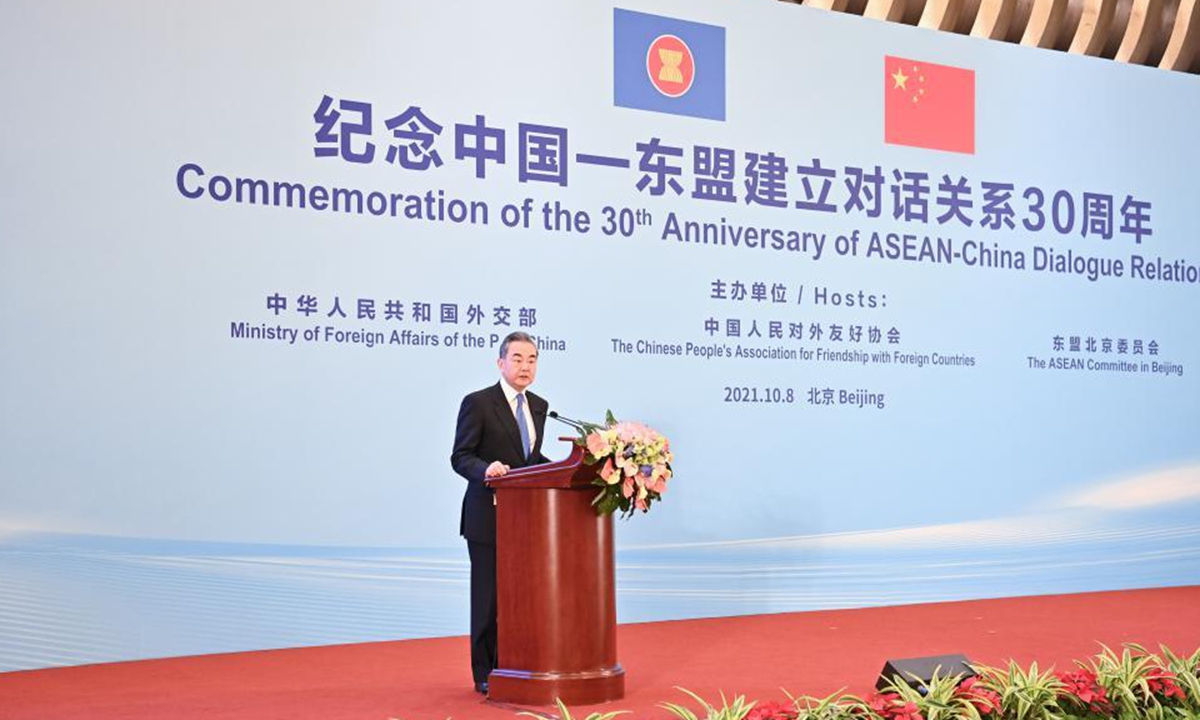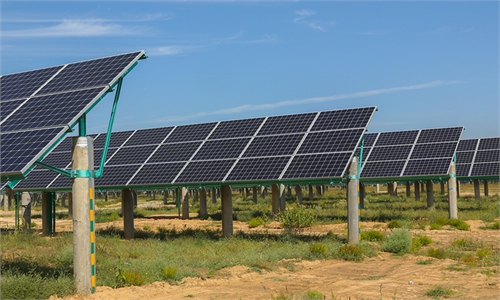
Chinese State Councilor and Foreign Minister Wang Yi speaks at a reception to commemorate the 30th anniversary of the establishment of dialogue relations between China and ASEAN in Beijing, capital of China, October 8, 2021. Photo: Xinhua
On November 14, State Councilor and Foreign Minister Wang Yi met with diplomatic envoys of the Association of Southeast Asian Nations (ASEAN) countries in Beijing. Noting that next year marks the 20th anniversary of the Declaration on the Conduct of Parties in the South China Sea (DOC), Wang Yi expressed hope that the two sides will take this opportunity to advance consultations on COC in the South China Sea based on the comprehensive and effective implementation of the DOC, jointly uphold peace and stability in the South China Sea, and seek win-win cooperation.
Oceans are an internal and essential component of the ecosystem for international society, including both China and ASEAN states. In fact, 67% of the world's population live within 400 kilometers from the coast, and 61% of global GDP comes from the ocean and coastal areas within 100 kilometers of the coastline. The annual gross marine product of the oceans totals US$2.5 trillion per year , making it the eighth largest economy of the world. Before the COVID-19 pandemic, the ocean economy contributed over 31 million direct full-time jobs.
The "Blue economy" has become a popular term for this emerging focus on coasts and oceans as a sustainable driver of economic growth. While the concept of blue economy has been around for many years, no shared definition yet exists. At present, several organizations and governments are developing their own understanding of what this means.
The coastal and marine environment in Southeast Asia is one of the richest areas in the world. The region is home to over one third of all coral reefs and mangroves, and hosts the highest levels of biodiversity for fish and sea grass species. This ecological abundance provides the foundation for economic development.
The annual economic benefit per square kilometer of healthy coral reef in Southeast Asia ranges from US$23,100 - US$270,000. East Asia is the top region globally for seafood exports. It sees China, Thailand, and Vietnam as the 3 leading seafood exporting countries. Marine and coastal industries such as ports and shipping, fishing and coastal tourism comprise roughly 15 to 20 percent of the GDP in some countries.
At present, China and ASEAN countries are moving forward on the road of fighting the COVID-19 pandemic and promoting economic recovery. But what cannot be ignored is this fact: Southeast Asia is also facing a complex and unique international political ecology.
On one hand, economic cooperation between countries in the region is strong. But at the same time, traditional security issues in this region have long existed. The strategic game among major powers has become increasingly fierce.
The supply of international public goods such as marine environmental protection, conservation of biological resources, safety of maritime routes, maritime search and rescue is difficult for the growing needs of regional countries.
The more complex the situation, the more regional countries should maintain the momentum of maritime cooperation. This past October, the ASEAN Summit adopted the ASEAN Leaders' Declaration on the Blue Economy. This demonstrates ASEAN's great confidence and determination in promoting the sustainable development of the marine economy and deepening international cooperation. At the 24th China-ASEAN Summit, Chinese Premier Li Keqiang also said that China hopes to work with ASEAN to speed up the building of the Partnership on Blue Economy.
The establishment of the China-ASEAN partnership on blue economy is one of the important goals set in the China-ASEAN Strategic Partnership Vision 2030. It is timely to launch cooperation on the blue economy, because this meets the development needs of countries and the region after COVID-19. It is conducive to enhancing the vitality and resilience of sustainable development and promoting economic recovery and improvement of people's livelihood.
China and ASEAN are facing multiple opportunities in developing the blue economic partnership. The concept of sustainable ocean development has had a wide-ranging impact on regional countries. Deepening cooperation in regional ocean governance has become a consensus among regional countries. Many achievements have been made in maritime economic cooperation between China and ASEAN countries. In this light, the foundation for the establishment of a blue economic partnership between the two parties has become increasingly solid.
Trade volume between China and ASEAN has jumped from less than 8 billion US dollars to 684.6 billion US dollars, an increase of more than 80 times. In the first quarter of 2021, ASEAN continued to maintain its position as China's largest trading partner, with a year-on-year increase of 26.1%. Among them, the marine economy plays an important role.
The entry into force of RCEP also provides a more comprehensive system to guarantee the sustainable development of the blue economic cooperation between the two parties. The role of RCEP in promoting the China-ASEAN Blue Partnership will become more apparent in the next few years.
The development of science and technology has created favorable conditions for the two parties to establish a blue economic partnership. China has rich experience in port construction, port management, shipping and logistics, fisheries, aquaculture, and marine renewable energy, which can be shared with ASEAN countries.
Fishery cooperation is an important part of the China-ASEAN Blue Economic Partnership. The cooperation between China and ASEAN countries in regards to fishing, aquatic product technology exchanges and seafood trade has been continuously strengthened.
In 2019, the total aquatic product trade between China and ASEAN reached US$3.649 billion. Among them, China imported 1.553 billion US dollars worth of aquatic products from ASEAN, and in kind exported 2.096 billion US dollars of aquatic products to ASEAN. Over the years, China has helped ASEAN countries train many fisheries management and technical personnel, improved their capabilities, and promoted practical cooperation in marine aquaculture.
In the future, China and ASEAN can start from several aspects to deepen fishery cooperation under the framework of the Blue Economic Partnership. The first major move will be to make an institutional design for the development and protection of fishery resources in the COC consultation. We must consider the timetable and roadmap for fishery cooperation mechanism of the South China Sea.
The second is to improve the multi-level fishery cooperation mechanism between China and ASEAN countries. This includes the fishery resource survey, information sharing between the fishery governance departments, and the programmatic cooperation between scientific research institutes.
The third is to strengthen policy exchanges and coordination between China the ASEAN countries under the multilateral framework of the United Nations Food and Agriculture Organization (FAO), the Asia-Pacific Fisheries Commission (CAPIFC), and the Asia-Pacific Aquaculture Center (NACA).
Last but not the least, there is an aim to improve the ties between the fishery industry associations of China and ASEAN countries, and to improve the market service mechanism for fishery enterprises. We will also accelerate the construction of international fishery industry cooperation parks in ASEAN countries.
The author is deputy director and associate research fellow of the Research Center for Ocean Law and Policy at the National Institute for South China Sea Studies.

